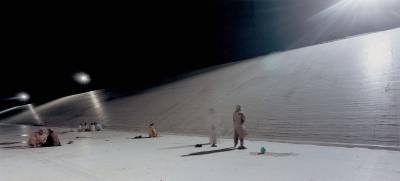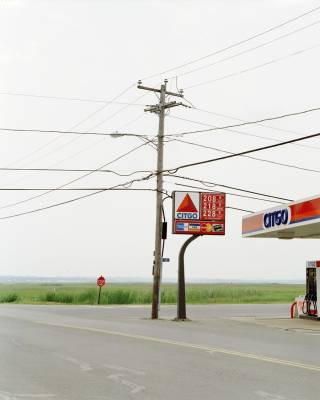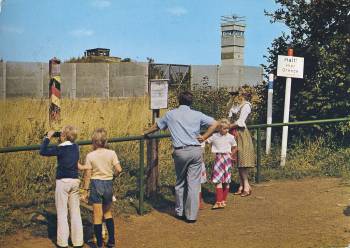Public Works

About the Exhibition
Featuring the work of:
Berenice Abbott
Harold Allen
Stephen Alvarez
David Avison
Tom Bamberger
Hubert Blanz
Andrew Borowiec
Frank Breuer
Mary Ellen Carroll
Alejandro Cartagena
Center for Land Use Interpretation
Chen Qiulin
Barbara Ciurej and Lindsay Lochman
Bruce Davidson
Tim Davis
Mitch Epstein
Terry Evans
Walker Evans
Robert Frank
Lee Friedlander
Ron Gordon
Eirik Johnson
Kenneth Josephson
Jay King
Viktor Kolár
Dorothea Lange
Russell Lee
Gina LeVay
O. Winston Link
Armin Linke
Vera Lutter
Danny Lyon
David Maisel
Rhondal McKinney
Tyagan Miller
Richard Misrach
Carl Mydans
Martin Parr
John Pfahl
David Plowden
Merle Porter
James Rotz
Victoria Sambubaris
Daniel Shea
Toshiro Shibata
Mark Slankard
Michael A. Smith
Jamey Stillings
Stan Strembicki
Bob Thall
Sze Tsung Leong
Catherine Wagner
Andy Warhol
Jay Wolke
Thomas Weinberger
Xu Xixian and Xu Jianrong
When I was teaching at Cooper Union in the first year or two of the ’50s, someone told me how I could get onto the unfinished New Jersey Turnpike. I took three students and drove from somewhere in the Meadows to New Brunswick. It was a dark night and there were no lights or shoulder markers, lines, railings or anything at all except the dark pavement moving through the landscape of the flats, rimmed by hills in the distance, but punctured by stacks, towers, fumes and colored lights. This drive was a revealing experience. —Minimalist artist Tony Smith recounting his sheer awe of the built environment during the transformative drive that made him reconsider the entire meaning of art.
Robust infrastructure has become a defining characteristic of modern civilizations. It enables the economic productivity that drives prosperity and confers the public safety that citizens of the developed world have come to expect. Indeed, a state’s (or regime’s) legitimacy and competence are often measured in large part by the sophistication of its infrastructure, as the manifestation of a government’s efficacy. The inadequacies of New Orleans’ levee system exposed by Hurricane Katrina in 2005, compounded with a federal response that left much to be desired, undermined public confidence in government at many levels. On the other hand, often awe-inspiring in its colossal scale and technical complexity, infrastructure sometimes serves as a functional monument to national accomplishment, attracting curious and faithful pilgrims to even the most remote sites. In this way, the modern state is both literally and figuratively constructed through infrastructure.
Certainly, political actors in control of public finances have frequently used infrastructure as the cornerstone of national renewal. Adolph Hitler, for example, was responsible for one of the largest infrastructure improvement projects in German history. In the United States, Franklin Delano Roosevelt sought to reinvigorate the economy during the Great Depression through large power generation projects, including the Hoover Dam and the Tennessee Valley Authority. The Works Progress Administration (WPA) hired otherwise unemployed workers to build and maintain the country’s roads, bridges, and dams, and the Farm Security Administration (FSA) paid photographers to document this progress, with an eye toward conveying optimism. More recently, in an effort to rev up the sluggish economic recovery, President Obama has proposed billions in spending to improve the nation’s roads, airports, and railways.
The social dislocations associated with large infrastructure are sometimes commensurate with the scale of the projects. The Three Gorges Dam in China, praised for providing much of the country’s electricity and alleviating the threat of catastrophic regional floods, permanently submerged 1,200 cities and villages and displaced more than a million people.
Public Works examines geographically and chronologically diverse examples of built infrastructure captured through the lenses of mid-20th century to contemporary artists. Modern infrastructure shares with photography a peculiar history, as the medium is particularly well suited to documenting the grandeur of large public works. Cumulating from the Museum of Contemporary Photography’s permanent collection and the Midwest Photographers Project, as well as from external loans, Public Works includes works by more than 50 international artists. Martin Parr’sBoring Postcards collection and Merle Porter’s 1950s postcards of the Dwight D. Eisenhower interstate highway system draw our attention to how public infrastructure became tourist spectacle in the postwar era. Frank Breuer’s photographs of tangled and antiquated, but still essential urban power lines in US cities, along with Tyagan Miller’s astute observations of trees that have been pruned or dramatically truncated to avoid the telephone and power lines, stand in striking contrast to prevailing assumptions about this country’s technological sophistication. Tim Davis photographs the desks of Washington’s political insiders, oftentimes the decision maker for public-funded infrastructure projects. Video and performance artist Chen Qiulin makes poetic films of the chaotic dismantling of cities for the construction of the Three Gorges Dam and of the effects of modernization on the multiple generations living in the Sichuan province of southwestern China. Armin Linke has photographed major infrastructure projects all over the world, including the workers on a prayer break at the Ghazi Barotha hydroelectric plant in Hattian, Pakistan. The Center for Land Use Interpretation, a research organization based in Culver City, California has filmed the Houston Petrochemical Corridor, whose massive petroleum refineries and shipping yards inspire contemplation. And adventurous artists expose the public to hidden infrastructure systems that most people take for granted, as Gina LeVay goes 800 feet below Manhattan to document Sandhogs—the miners tunneling bedrock to create the 60-mile-long city water tunnel that will provide fresh water to New Yorkers. Generally regarded as profoundly boring, infrastructure, we see through this work, has complex political, economic, and social dimensions.
—Natasha Egan, Associate Director and Curator
“Public Works: Global Design for Aging Infrastructure” featuring Bruce Mau and Armin Linke at the Museum of Contemporary Photo from MoCP, Columbia College Chicago on Vimeo.
Matthew Coolidge of the Center for Land Use Interpretation discusses his work at the Museum of Contemporary Photo (Part 1) from MoCP, Columbia College Chicago on Vimeo.
Matthew Coolidge of the Center for Land Use Interpretation discusses his work at the Museum of Contemporary Photo (Part 2) from MoCP, Columbia College Chicago on Vimeo.
Image Gallery


